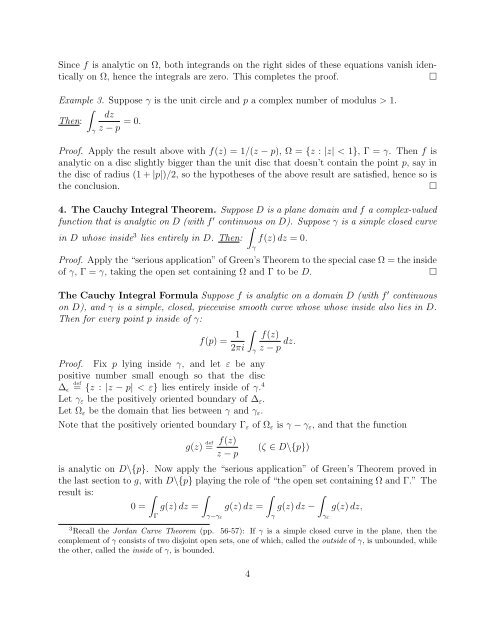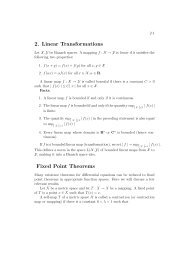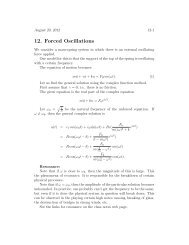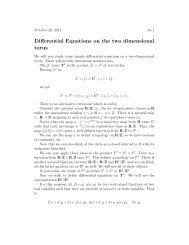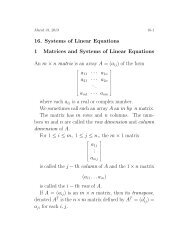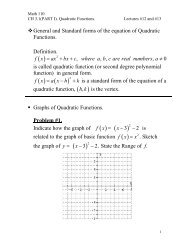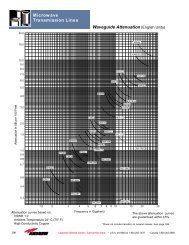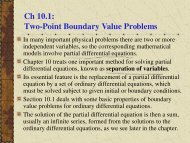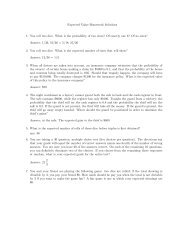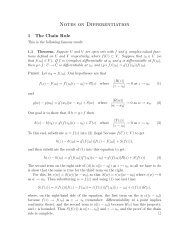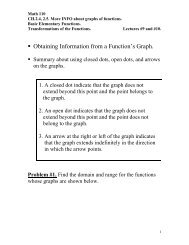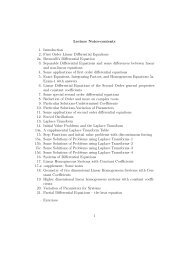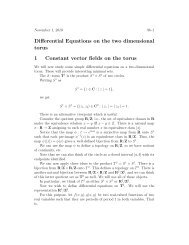Green's Theorem, Cauchy's Theorem, Cauchy's Formula
Green's Theorem, Cauchy's Theorem, Cauchy's Formula
Green's Theorem, Cauchy's Theorem, Cauchy's Formula
You also want an ePaper? Increase the reach of your titles
YUMPU automatically turns print PDFs into web optimized ePapers that Google loves.
Since f is analytic on Ω, both integrands on the right sides of these equations vanish identicallyon Ω, hence the integrals are zero. This completes the proof.□Example 3. Suppose γ is the unit circle and p a complex number of modulus > 1.∫dzThen:z − p = 0.γProof. Apply the result above with f(z) = 1/(z − p), Ω = {z : |z| < 1}, Γ = γ. Then f isanalytic on a disc slightly bigger than the unit disc that doesn’t contain the point p, say inthe disc of radius (1 + |p|)/2, so the hypotheses of the above result are satisfied, hence so isthe conclusion.□4. The Cauchy Integral <strong>Theorem</strong>. Suppose D is a plane domain and f a complex-valuedfunction that is analytic on D (with f ′ continuous ∫ on D). Suppose γ is a simple closed curvein D whose inside 3 lies entirely in D. Then: f(z) dz = 0.Proof. Apply the “serious application” of Green’s <strong>Theorem</strong> to the special case Ω = the insideof γ, Γ = γ, taking the open set containing Ω and Γ to be D.□The Cauchy Integral <strong>Formula</strong> Suppose f is analytic on a domain D (with f ′ continuouson D), and γ is a simple, closed, piecewise smooth curve whose whose inside also lies in D.Then for every point p inside of γ:f(p) = 12πiProof. Fix p lying inside γ, and let ε be anypositive number small enough so that the discdef∆ ɛ = {z : |z − p| < ε} lies entirely inside of γ. 4Let γ ε be the positively oriented boundary of ∆ ε .Let Ω ε be the domain that lies between γ and γ ε .∫γγf(z)z − p dz.Note that the positively oriented boundary Γ ε of Ω ε is γ − γ ε , and that the functiong(z) def= f(z)z − p(ζ ∈ D\{p})is analytic on D\{p}. Now apply the “serious application” of Green’s <strong>Theorem</strong> proved inthe last section to g, with D\{p} playing the role of “the open set containing Ω and Γ.” Theresult is:∫ ∫∫ ∫0 = g(z) dz = g(z) dz = g(z) dz − g(z) dz,Γγ−γ ε γγ ε3 Recall the Jordan Curve <strong>Theorem</strong> (pp. 56-57): If γ is a simple closed curve in the plane, then thecomplement of γ consists of two disjoint open sets, one of which, called the outside of γ, is unbounded, whilethe other, called the inside of γ, is bounded.4


